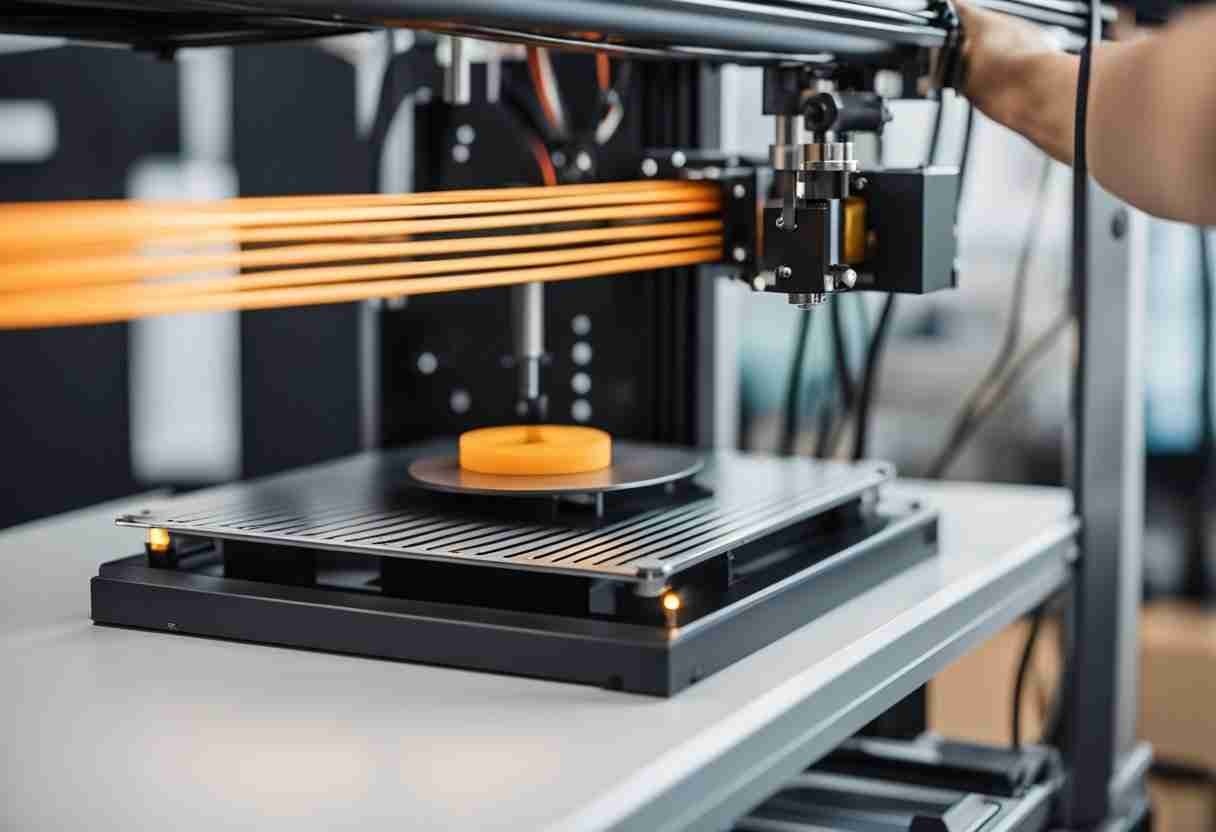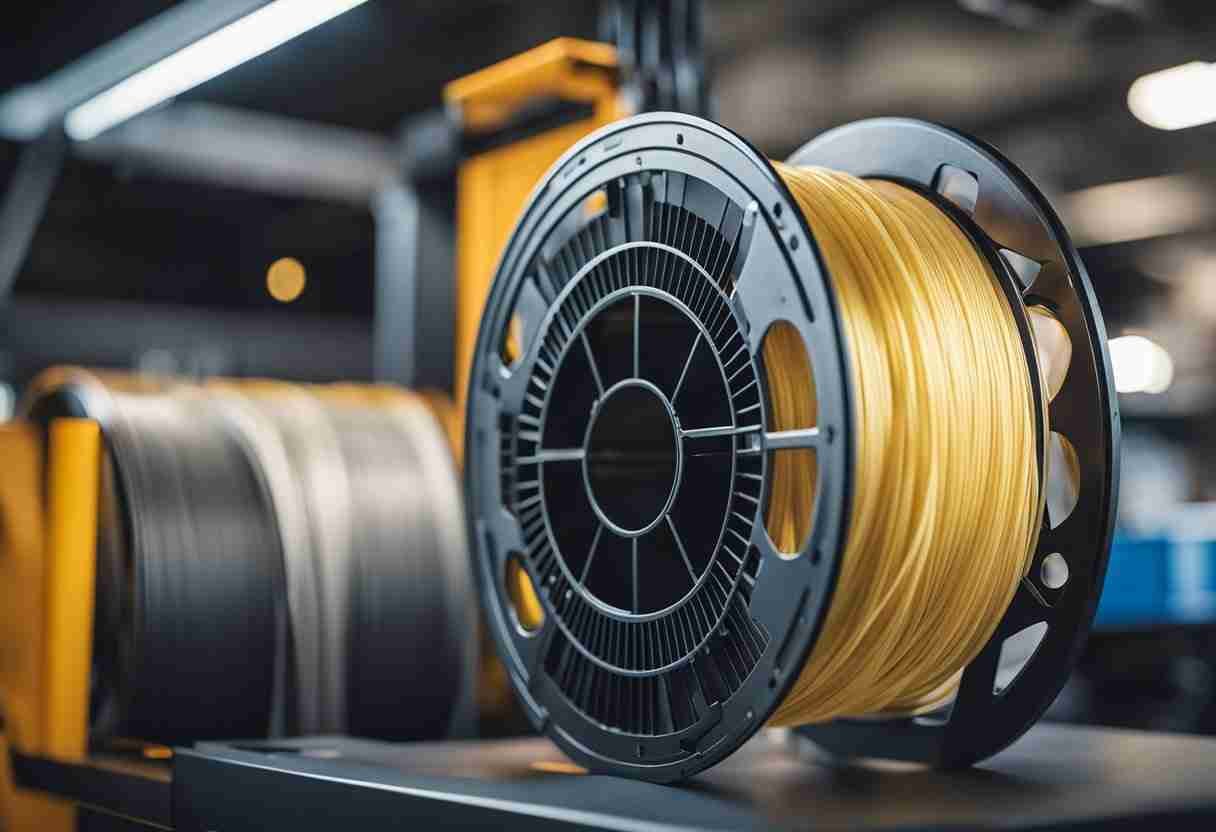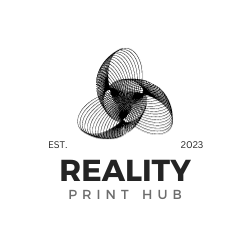One of the essential components of 3D printing is the filament used as printing material. Polylactic Acid (PLA) has become popular due to its biodegradability, ease of use, and low cost. Selecting the best PLA filament for 3D printing is crucial in achieving high-quality prints.

The best PLA material depends on many factors, such as strength, durability, and print quality. Two 3D printing parameters that affect PLA's mechanical properties are filling density and printing temperature. Finding the optimal settings to achieve the best results is necessary to prevent issues like water absorption and poor layer adhesion. Additionally, the printing speed and layer arrangement can impact the final product, with some studies focusing on optimizing these parameters.
Numerous PLA filaments are available on the market, each offering unique properties and advantages. The intended application, budget, and desired finish must be considered to find the best PLA filament for a 3D printing project.
Understanding PLA Filament
Origin and Composition
Polylactic acid, or PLA, is a thermoplastic polymer derived from renewable resources such as sugar cane and corn starch. PLA is one of the most eco-friendly options available for 3D printing since it is made from natural materials. It is also biodegradable, which makes it a popular choice for environmentally conscious users.
The production process for PLA consists of fermenting plant-based materials to create lactic acid. This chemical byproduct is then polymerized to form the polylactic acid filament. This method supports a lower carbon footprint compared to petroleum-based plastics.
PLA Variants: Standard, Tough, and Enhanced
Various types of PLA are available in the market, each with specific properties and applications. The following list highlights three main PLA variants:
- Standard PLA: The most common type of PLA filament, known for its ease of use, low cost, and good print quality. It suits various applications, from simple prototypes to more complex design models.
- Tough PLA: As the name suggests, this variant of PLA offers enhanced strength and durability compared to standard PLA. It is ideal for creating functional parts and models that require high-impact resistance without compromising the ease of printing.
- Enhanced PLA: This category consists of modified PLA filaments, where additives (such as colorants, fillers, or reinforcements) are added to improve heat resistance, UV resistance, or appearance. Examples of enhanced PLA include wood-filled, metal-filled, or glow-in-the-dark filaments.
PLA Variant | Strength | Ease of Printing | Best Applications |
|---|---|---|---|
Standard PLA | Low | High | General prototyping, simple designs |
Tough PLA | High | Medium | Functional parts, impact-resistant models |
Enhanced PLA | Varies | Varies | Specific properties or appearance |
In summary, PLA filament is a versatile and environmentally friendly option for 3D printing. Users can make informed decisions for their projects by understanding the origins, compositions, and properties of each variant of PLA.
Choosing the Best PLA Filament

Selecting the best PLA filament for 3D printing is essential for producing high-quality prints. This section will discuss the performance aspect of brand-specific materials and why it is important to read reviews and recommendations.
Impact of Brand on Performance
Filament manufacturers offer varying levels of quality and performance. Some well-known brands are more likely to produce high-quality filaments, while lesser-known brands may offer lower-quality products at a more affordable price. However, this is not always the case. Take time to evaluate the quality of the PLA filament based on consistency, color, and strength:
- Consistency: A consistent diameter is essential for smooth printing and to minimize clogs or jams.
- Color: The vibrancy and accuracy of colors affect the appearance of your printed objects.
- Strength: The strength of the printed object depends on the quality of the PLA filament.
Reading Reviews and Recommendations
Researching filament reviews can be a valuable method to find the best PLA filament for your project. In addition to user reviews, professional recommendations can offer valuable insights into filament performance.
Some useful resources include:
- Online forums: 3D printing enthusiasts often share their experiences with PLA filaments on community forums and discussion boards.
- Industry publications: Experts and professionals in the 3D printing industry may offer recommendations in blog articles and magazines.
- Social media channels: Users often share their experiences with specific PLA filaments on social media platforms.
Finding the best PLA filament for 3D printing requires research, understanding brand-specific quality, and consulting user reviews. Investing time in the selection process increases the likelihood of finding the correct filament for your 3D project.
Printing with PLA: Best Practices

When using PLA for 3D printing, following best practices helps to ensure optimal print quality and reduce issues during the process. This section will discuss two important aspects: optimal printing temperatures and bed and nozzle adjustments.
Optimal Printing Temperatures
Finding the right printing temperature for PLA is paramount to achieving the best print results. PLA typically prints at lower temperatures compared to other materials. A good starting point for PLA is between 190°C and 220°C. However, the optimal temperature may vary depending on the specific brand or color of the filament. It is advised to consult the manufacturer's guidelines for the recommended temperature range.
To minimize stringing and oozing, adjust the retraction settings in your slicer. A 0.5mm to 2mm retraction distance is usually sufficient for PLA. Additionally, increasing the speed at which the printing head retracts can help resolve these issues.
In general, using a heated bed is not necessary for PLA. If your printer has a heated bed, it can be set to a bed temperature of approximately 60°C for improved first-layer adhesion. Always ensure the bed is leveled correctly to avoid lifting and warping issues.
Bed and Nozzle Adjustments
Before printing with PLA, it's essential to fine-tune the gap between the nozzle and the bed. Accurate bed leveling will ensure good first-layer adhesion and avoid lifting problems during printing.
Use a piece of paper between the nozzle and the bed as a feeler gauge when adjusting the bed. The gap should be snug enough for the paper to slide under the nozzle with a slight resistance.
To recap, bed and nozzle adjustments consist of the following:
- Nozzle temperature: Start with a nozzle temperature between 190°C and 220°C
- Bed temperature: If using a heated bed, set the temperature to approximately 60°C
- Retraction: Set the retraction distance between 0.5mm to 2mm.
By following these best practices for PLA 3D printing, you can achieve high-quality prints with fewer issues during printing. Consult the manufacturer's guidelines and test different settings to find the optimal setpoint for your PLA filament.
Comparing PLA to Other Filaments

When exploring the world of 3D printing, it's important to understand the different types of filaments available. This section will compare PLA to other commonly used filaments - ABS, PETG, and TPU.
ABS vs. PLA
Acrylonitrile Butadiene Styrene (ABS) and Polylactic Acid (PLA) are the most commonly used filaments in 3D printing. Here is a brief comparison of their properties:
Property | ABS | PLA |
|---|---|---|
Durability | High | Moderate |
Flexibility | High | Low to moderate |
Printability | Tricky, requires a heated bed | Easier to print, heated bed not required |
Warping | Moderate | Less prone to warping |
Smell | Unpleasant | Less noticeable |
Eco-friendly | Non-biodegradable | Biodegradable (made from plant-based materials |
PLA is easy to use and has reduced warping, while ABS is more durable and flexible1.
PETG and TPU: When to Use Them
Polyethylene Terephthalate Glycol (PETG) and Thermoplastic Polyurethane (TPU) are other popular 3D printing filaments with specific properties that might be preferable depending on the application.
PETG is a copolyester similar to PLA but boasts improved heat resistance and durability2. Some key characteristics of PETG include:
- Strong and flexible
- Excellent layer adhesion
- Low odor
- Resistant to water, moisture, and chemicals
PETG is suitable for functional parts such as mechanical parts, food containers, electronic enclosures, and protective casings3.
TPU is a flexible filament with rubber-like properties. Features of TPU filaments:
- Highly flexible and resilient
- Strong layer bonding
- Resistant to abrasion, wear, and impact
- Requires slower printing speeds and proper temperature control
TPU is ideal for projects that require elasticity and flexibility, like phone cases, gaskets, seals, and wearable items4.
In summary, PLA filament offers a good balance of printability, eco-friendliness, and adequate mechanical properties for many projects. Filaments like ABS, PETG, and TPU may better suit a specific application. This depends upon the project's durability, flexibility, and heat resistance needs.
Footnotes
Advantages of PLA for Different Applications

Polylactic acid (PLA) is a popular material for 3D printing due to its ease of use and environmentally friendly nature. It offers several advantages in home projects, consumer products, industrial applications, and end-use parts. This section will explore the benefits of PLA for these different applications.
Home Projects and Consumer Products
PLA is an excellent choice for home projects and consumer products. It is a biodegradable material, which makes it an attractive option for environmentally conscious consumers. Additionally, it is relatively easy to print with, allowing for a wide range of 3D printing applications.
- Ease of use: PLA has a lower melting point than other 3D printing materials.
- Compatibility: It is compatible with most desktop 3D printers.
- Aesthetics: PLA can be found in many different colors and finishes.
Industrial Applications and End-Use Parts
While PLA may not always be ideal for high-strength or high-temperature applications, it still offers several advantages for industrial applications. PLA blends and composites can enhance mechanical properties for demanding situations 1. Advantages of PLA in industrial applications:
- Biodegradability: In industries focused on sustainability, PLA's biodegradable property makes it a suitable option for certain end-use parts.
- Customization: Manufacturers can modify the properties of PLA to increase its strength and thermal stability by incorporating additives.
- Cost-effectiveness: Because PLA is a low-cost material, it is a good choice for sectors where cost-effectiveness is necessary.
In conclusion, PLA has numerous advantages in various applications, from consumer products to industrial components. The biodegradable nature, simplicity of use, widespread availability, and customization options of PLA are preferred by enthusiasts and professionals.
Achieving Optimal Print Quality with PLA
Layer Adhesion and Part Strength
Achieving optimal print quality with PLA is essential for producing solid and well-finished parts. One critical aspect of this process is ensuring strong layer adhesion. A few factors to achieve this include:
- Temperature: Choosing the right temperature for the extruder and the heated bed is vital for good layer adhesion. Typically, PLA requires extruder temperatures between 190-220°C and heated bed temperatures around 50-60°C.
- Layer Height: Smaller layer heights generally result in a smoother finish and better adhesion. However, this increases the print time. Find a good balance between quality and efficiency.
- Print Speed: Slower print speeds help achieve stronger layer bonding. However, printing too slowly can lead to print failures. Experiment with different print speeds to find the ideal setting.
Reducing Warping and Print Failures
To minimize warping and print failures with PLA, focus on the following:
- Bed Adhesion: Use a clean and leveled print bed. Employ surface adhesion techniques, such as painter's tape, a glue stick, or a PEI sheet, to ensure the first layer sticks well and prevents warping during the print process.
- Enclosure: Although PLA doesn't usually require a heated enclosure, using one can help maintain a stable environment for the print.
- Cooling: Efficient cooling is a must for producing high-quality PLA prints. Make sure your cooling fans work correctly.
By following these recommendations, achieving optimal print quality with minimal warping and print failures is possible. This results in stronger and visually appealing PLA-printed parts.
PLA for Longevity: Durability and Mechanical Properties
Regular PLA vs. PLA+
Regular PLA is a widely used filament for 3D printing. It is known for its biodegradability and ease of use. PLA provides good print quality and detail, but it might not be ideal for parts requiring longevity. On the other hand, PLA+ (also known as PLA Pro or PLA Plus) is an enhanced version of PLA designed explicitly with enhanced robustness and impact resistance.
Benefits of PLA+:
Impact Resistance: PLA+ has been formulated to have better impact resistance than regular PLA, making it suitable for applications where parts are exposed to external forces or vibrations.
Strength: Due to its enhanced formulation, PLA+ offers increased strength over regular PLA, contributing to the longevity of 3D-printed objects.
Properties of Tough PLA
Tough PLA is another variation of PLA. It is specifically designed for increased toughness and durability, suitable for applications requiring long-lasting parts. The following table highlights some key differences between Regular, PLA+, and Tough PLA:
Material | Impact Resistance | Strength | Durability | Ideal Applications |
|---|---|---|---|---|
Regular PLA | Moderate | Good | Moderate | Decorative pieces, simple prints, low-stress parts |
PLA+ | Improved | Better | Good | Functional parts, mechanical components |
Tough PLA | High | Better | Excellent | High-stress parts, engineering applications |
Tough PLA offers the highest impact resistance and durability among the three materials. Its mechanical properties are closer to ABS while maintaining PLA's ease of use and environmental benefits. Tough PLA is the best choice for creating 3D-printed parts that must withstand long periods of use.
In summary, PLA+ and Tough PLA provide enhanced mechanical properties for applications that require a longer lifespan.
Innovations in PLA Filament Manufacturing
Custom Colors and Effects
3D printing has seen significant advancements in PLA filament manufacturing, with custom colors readily available for users. These innovations in color options have expanded the possibilities for creative exploration in the industry. PLA filaments are now available in different colors with effects such as metallic, fluorescent, and multicolor gradients.
It's now easier than ever for users to experiment with different aesthetic options while benefiting from PLA's eco-friendly properties.
Composite PLAs: Adding Wood, Metal, or Carbon Fiber
Another significant innovation in PLA manufacturing is the creation of composite filaments that combine the properties of PLA with various materials, such as wood, metal, or carbon fiber. These composite filaments offer unique aesthetics to printed objects and enhance their performance.
- Wood PLA: By incorporating wood fibers or sawdust into the PLA mix, wood PLA offers the convincing appearance and feel of wood. This combination results in attractive printed objects with varying wood shades and grains.
- Metal PLA: Metal powder mixed with PLA produces a metal-like filament. This innovative approach provides options for making detailed, metal-like prints without the need for traditional metalworking processes.
- Carbon Fiber PLA: Adding chopped carbon fiber strands to PLA creates a carbon fiber PLA filament that is lighter and stronger than traditional PLA filaments. Carbon fiber PLA delivers improved stiffness and increased dimensional stability.
Manufacturing of PLA filaments has expanded 3D printing possibilities in colors, textures, and mechanical properties. With these advances, PLA filaments offer new prospects in 3D printing.
The Role of Temperature in PLA Printing
Effects of Low vs. High Nozzle Temperatures
Lower temperatures, typically ranging from 180°C to 200°C, help reduce stringing. The PLA filament cools down relatively quickly at these temperatures, producing a cleaner finish on the printed object. However, lower temperatures may result in poor layer adhesion, leading to weak and brittle prints.
On the other hand, PLA printed at higher temperatures (210°C to 230°C) exhibits improved layer adhesion and strength ^1^. The melted PLA flows better at these temperatures, producing more robust prints. The downside of high temperatures is the increased chance of stringing and bobbing on the printed object.
Balancing Print Speed and Temperature
It's important to balance print speed and nozzle temperature when using PLA in 3D printing. Faster print speeds require higher nozzle temperatures to maintain consistent filament flow. However, a high temperature can compromise print quality and create unwanted artifacts.
For optimal results with PLA, starting with a moderate print speed, around 40-60mm/s is recommended. The ideal PLA temperature range (typically 190°C-220°C) is set based on your specific filament type ^2^. Adjust the nozzle temperature and print speed if you experience stringing or poor layer adhesion.
In summary, the temperature setting in PLA printing affects overall quality and strength. Find a suitable balance between nozzle temperature and print speed to achieve the best results.
Community Insight: Learning from the 3D Printing Community
Popular Filament Brands Among Hobbyists
The 3D printing community is an excellent resource for finding the best PLA filaments for printing projects. Two popular filament brands among hobbyists are Hatchbox PLA and Overture PLA. Hatchbox PLA is known for its consistent quality, smooth prints, and wide range of colors. Similarly, Overture PLA is praised for its reliability and ease of use. These filament options are recommended for everyday use by 3D printing enthusiasts.
Here are some highlights of the popular filament brands:
- Hatchbox PLA:
- Consistent quality
- Smooth prints
- Wide range of colors
- Overture PLA:
- Reliable
- Easy to use
- Good for various applications
Community Recommendations for Specific Projects
When selecting the best PLA for specific projects, the 3D printing community offers valuable insights. For example, users have reported success with Hatchbox PLA for intricate, detailed prints, such as miniatures or prototypes. On the other hand, Overture PLA is ideal for projects that require a sturdy, functional part, such as support structures or mechanical parts.
n conclusion, by tapping into the 3D printing community's knowledge and experience, hobbyists can decide which PLA filament brands to use for different printers and projects. Hatchbox PLA and Overture PLA consistently receive positive feedback for their quality and versatility. Still, additional community insights can help guide users toward the best filament for a specific task.
